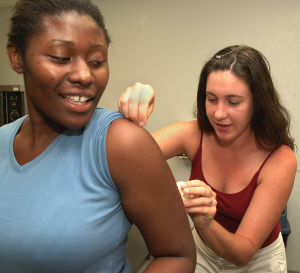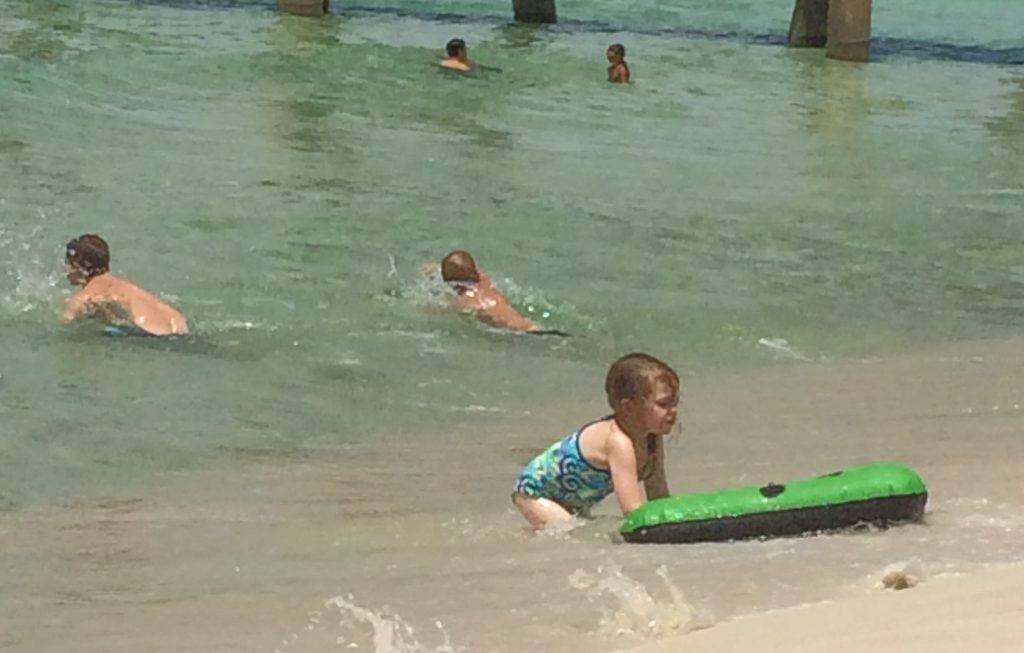
by Melanie Taylor | Mar 12, 2020

Speak openly with your doctor about any concerns you may have regarding your health. (Photo source: Tyler Jones, UF/IFAS)
We are in the depths of flu season and now the Coronavirus (COVID-19). Although we need to proceed with caution, we also want to avoid causing a panic. Both viruses are very concerning, but with good hand washing skills and a few other daily steps you can do your best to prevent you and your family from becoming sick.
Hand washing is one of the best ways to protect yourself and your family from getting sick. You can help yourself and your loved ones stay healthy by washing your hands often, especially during these key times when you are likely to get and spread germs:
- Before, during and after preparing food
- Before eating food
- Before and after caring for someone at home who is sick with vomiting or diarrhea
- Before and after treating a cut or wound
- After using the toilet
- After changing diapers or cleaning up a child who has used the toilet
- After blowing your nose, coughing or sneezing
- After touching an animal, animal feed or animal waste
- After handling pet food or pet treats
- After touching garbage
Follow these Five Steps Every Time You Wash Your Hands:
- Wet your hands with clean, running water (warm or cold) and apply soap.
- Lather your hands by rubbing them together with the soap. Lather the backs of your hands, between your fingers and under your nails.
- Scrub your hands for at least 20 seconds. Need a timer? Hum the “Happy Birthday” song from beginning to end twice.
- Rinse your hands well under clean, running water.
- Dry your hands using a clean towel or air dry them.
Use Hand Sanitizer When You Can’t Use Soap and Water
You can use an alcohol-based hand sanitizer that contains at least 60% alcohol if soap and water are not available. Washing hands with soap and water is the best way to get rid of germs in most situations. If soap and water are not readily available, you can use an alcohol-based hand sanitizer that contains at least 60% alcohol. You can tell if the sanitizer contains at least 60% alcohol by looking at the product label.
- Sanitizers can quickly reduce the number of germs on hands in many situations.
- Sanitizers do not get rid of all types of germs.
- Hand sanitizers may not be as effective when hands are visibly dirty or greasy.
- Hand sanitizers might not remove harmful chemicals from hands like pesticides and heavy metals.
How to Properly Use Hand Sanitizer:
- Apply the gel product to the palm of one hand (read the label to learn the correct amount).
- Rub your hands together.
- Rub the gel over all the surfaces of your hands and fingers until your hands are dry. This should take around 20 seconds.
Caution! Swallowing alcohol-based hand sanitizers can cause alcohol poisoning if more than a couple of mouthfuls are swallowed. Keep it out of reach of young children and supervise their use.
Conclusion – Other Basic Tips to Prevent Spread of Illness:
- Wash your hands often with soap and water for at least 20 seconds. If soap and water are not available, use an alcohol-based hand sanitizer.
- Avoid touching your eyes, nose and mouth with unwashed hands.
- Avoid close contact with people who are sick.
- Stay home when you are sick.
- Cover your cough or sneeze with a tissue, then throw the tissue in the trash.
- Clean and disinfect frequently touched objects and surfaces.
Be sure to utilize credible sources to find your information. The Centers for Disease Control and Prevention (CDC) and the Florida Department of Health are excellent resources.
CDC page Preventing COVID-19 Spread in Communities https://www.cdc.gov/coronavirus/2019-ncov/community/index.html
CDC frequently asked questions (FAQs) https://www.cdc.gov/coronavirus/2019-ncov/downloads/2019-ncov-factsheet.pdf
Florida Department of Health frequently asked questions (FAQ) http://www.floridahealth.gov/diseases-and-conditions/COVID-19/faq.html
If you have further questions or concerns, please contact your local Department of Health for assistance.
Sources:
Center for Disease Control and Prevention – https://www.cdc.gov/
Florida Department of Health – http://www.floridahealth.gov/

by Melanie Taylor | Jan 9, 2020

One of the best ways to help prevent the flu this season is to get vaccinated. Even if you still get the flu, the severity and length of illness may be diminished. (Photo source: UF/IFAS file photo)
The holiday season has passed and now we are well on our way into 2020 with a very severe flu season. You are the best person at making sure you do not get the flu. Here are a few tips that you should consider as this flu season continues and still has not reached its peak.
- GET VACCINATED. It takes, on average, two weeks for the flu vaccine to reach its full potential, so if you have not gotten the flu shot, get it NOW. Even if you still get the flu, it will likely be shortened in time and strength if you are vaccinated.
- WASH YOUR HANDS. Washing your hands frequently will help protect you from the flu. If soap and water are not available, use an alcohol-based hand sanitizer.
- AVOID CLOSE CONTACT WITH PEOPLE WHO ARE SICK. Be sure to avoid direct contact with anyone that is sick. If you must come in contact with them be sure to wash your hands once you leave. If you are sick, keep your distance from others to protect them from getting sick too.
- AVOID TOUCHING YOUR FACE. Germs are spread quickly when a person touches something that is contaminated with germs and then touches his or her eyes, nose, or mouth. So make a conscious effort to keep your hands away from your face.
- COVER YOUR MOUTH AND NOSE WHEN YOU COUGH AND SNEEZE. Cover your mouth and nose with a tissue when coughing or sneezing, or sneeze/cough into your closed elbow. These steps may prevent those around you from getting sick.
- STAY HOME WHEN YOU ARE SICK. If possible, stay home from work and school when you are sick. This is the best way to avoid spreading your germs to other people. The CDC (Centers for Disease Control and Prevention) recommends you stay home for at least 24 hours after your fever is gone except to get medical care or for other necessities. They also recommend that your fever should be gone for 24 hours (without the use of a fever-reducing medicine) for you to no longer be considered contagious.
- PRACTICE GENERAL GOOD HEALTH HABITS. Clean and disinfect frequently touched surfaces at home, work, and school, especially when someone is sick. Wash backpacks, coats, and other items regularly. Get plenty of sleep, be physically active, manage your stress, drink plenty of fluids, and eat nutritious food.
Follow the tips above and maintain the best health practices possible and hopefully you will be one of the lucky people that avoids the dreaded flu this year. Wishing you all a healthy and happy 2020!
Source: https://www.cdc.gov/flu/prevent/prevention.htm

by Stephanie Herzog | Oct 11, 2019
Have you ever been bullied or know someone who has been bullied? I know I have. October is National Bullying Prevention Month. Each October since 2006, there has been a national effort to raise awareness about bullying and provide education and resources to try to prevent it. According to data from 2017, about 20% of youth ages 12-18 experienced bullying at school and nearly 30% reported cyberbullying during their lifetime. That is a lot of our country’s youth!
What Exactly is Bullying?
Bullying is unwanted aggressive behavior. Bullying must have a real or perceived power imbalance between the bully and the victim, where the bully uses their power to control or hurt their victim. The bullying behavior needs to be repeated over time, or at least have the potential to repeat over time.
There are three categories of bullying:
- Verbal bullying includes teasing, taunting, threats, or name-calling
- Social or relational bullying includes ignoring someone on purpose, ostracizing, spreading rumors, or embarrassing someone
- Physical bullying includes damaging belongings or harming another’s body such as spitting, hitting, pushing, rude gestures, or tripping

The constant and easy access of cell phones, social media, and the internet has increased the real dangers of cyberbullying. (Photo source: UF/IFAS)
Cyberbullying
Technology has changed the ways of bullying. Bullying is no longer only ‘picking on’ someone, making fun of them, calling them names, or ignoring them at school. The constant and easy access of cell phones, social media, and the internet has truly expanded bullying to an unthinkable, unending scale. There are many ways to bully someone online, including:
- Verbal attacks, mean messages, or rumors on social media accounts, online games such as Fortnite, or through email or text
- Releasing embarrassing or inappropriate pictures, GIFs, or videos online or through text (e.g. sexting)
- Creating fake profiles or hacking into someone’s account online in order to hurt that person
Perhaps one of the most dangerous things about cyberbullying is once something is posted online and is circulated, it’s very hard to permanently remove. This oftentimes makes escape from the bullying unusually difficult or even seemingly impossible. It’s so important to keep up with ways technology is advancing in order to protect ourselves from things like cyberbullying.
Effects of Bullying
The negative psychological effects of bullying are very real – for the bully, the victim, and those who may witness it.
For the bully, they have a greater risk of using substances, engaging in risky or violent behavior, being abusive in future relationships, committing crimes, and developing other external behavior problems.
Effects of bullying include low self-esteem, fear, loneliness, heartache, and potential physical illness. These effects put a widespread toll on the mental, physical, and social health of the victims and also those who witness bullying. The increased risk of using addictive and illegal substances, anxiety, depression, eating disorders or even becoming suicidal are to be taken seriously and should be treated appropriately. Seek out mental health professionals or physicians and consult with them on the best combination of treatment. These effects can last days, months, years, or even lifetimes depending on the person and the circumstance.
The Story of Amanda Todd
The story of Amanda Todd is an unfortunate real example of cyberbullying and how unforgiving and never-ending it can be. Amanda ultimately committed suicide to get away from it; she was only 15 years old. Her YouTube video, published in 2012 a month before she committed suicide, has 13.5 million views to date. To better understand the reality of bullying, please consider watching it or sharing it. However, viewer discretion is advised.
Bullying, harassment, discrimination, or any other type of negative, cruel, or harmful behavior is never okay or acceptable in any way. If you have been a witness of bullying or a bully, stand up to stop it! If you have been bullied or know someone who has, please seek help from caring professionals, family, or friends. Go-to resources are found below.
Additional Resources
Stop Bullying Now Hotline: 1-800-273-8255
- Available 24/7, managed by the U.S. Department of Health and Human Services
National Suicide Prevention Lifeline: 1-800-273-8255
- Available 24/7, there is an online chat option available here
The Trevor Project: 1-866-488-7386
- Available 24/7, suicide prevention help specifically for the LGBTQ+ community
- Texting and chat options are available here
National Eating Disorders Association: 1-800-931-2237
- Mon-Thu 9am-9pm, Fri 9am-5pm
The Cybersmile Foundation
STOMP Out Bullying
Stopbullying.gov
Sources
National Center for Educational Statistics, Indicators of School Crime and Safety Indicator 10: Bullying at School and Electronic Bullying, April 2019.
Cyberbullying Research Center
The Amanda Todd Legacy

by Melanie Taylor | Jan 18, 2019

Be mindful and enjoy the moment.
Photo source: UF/IFAS Northwest District
Now that the busy holiday season is over, it is time not only to reflect on the past, but to prepare and refocus for the New Year ahead. As we focus on the New Year, it is always refreshing to have a clean slate. As the year begins to unfold, there are tips to help you manage your day-to-day stress levels. It begins with mindfulness.
What is mindfulness? Mindfulness means paying attention in a particular way; on purpose, in the present moment, and nonjudgmentally.” –Dr. Jon Kabat-Zinn (1991)
Mindfulness is best thought of as a way of being rather than an activity in and of itself. Almost any activity can be carried out with mindful awareness.
Mindful awareness has three key features:
Purpose – mindfulness involves intentionally and purposefully directing your attention rather than letting it wander.
Presence – mindfulness involves being fully engaged with and attentive to the present moment. Thoughts about the past and future that arise are recognized simply as thoughts occurring in the present.
Acceptance – mindfulness involves being nonjudgmental toward whatever arises in the moment. This means that sensations, thoughts, and emotions are not judged as good or bad, pleasant or unpleasant; they are simply noticed as “happening,” and observed until they eventually pass (Naik, Harris, and Forthun 2016).
Mindfulness is a mind-body practice that has been found to benefit both psychological and physical health. The primary psychological change that occurs during mindfulness practice is an increased awareness of thoughts, feelings, and sensations in the present moment. Over time, mindfulness practice can help you to become aware of the space between noticing experiences and reacting to them by letting you slow down and observe the processes of your mind (Black 2010). The ultimate goal of mindfulness practice is for you to take advantage of this space so you can make more intentional decisions – to wake up from living life on autopilot, based on unproductive habits of mind (Black 2010; Walach et al. 2007).
According to the American Psychological Association, some empirically supported benefits of mindfulness include the following (Davis & Hayes 2011):
Psychological Benefits
Increased awareness of one’s mind
Significantly reduced stress, anxiety, and negative emotions
Increased control over ruminative thinking (a major cause and symptom of depression and anxiety)
Increased mental flexibility and focus
More working memory
Decreased distracting thoughts
Decreased emotional reactivity
Increased capacity for intentional, responsive behaviors
Increased empathy, compassion and conscientiousness of others’ emotions
Physiological Benefits
Enhanced immune system functioning
Increased brain density and neural integration in areas responsible for positive emotions, self-regulation, and long-term planning
Lowered blood pressure
Lowered levels of blood cortisol (a major stress hormone)
Greater resistance to stress-related illnesses such as heart disease
Spiritual Benefits
Increased self-insight and self-acceptance
Increased acceptance of others
Increased compassion and empathy
Increased sense of morality, intuition, and courage to change
Increased control over automatic behaviors
Increased self-discipline
The question is: how many of us would like to benefit from mindfulness if it provides these positive benefits? All of us should strive to lower our stress level and enjoy our daily lives with a more positive attitude and more attentiveness. So, how can we incorporate this into our lives? The majority of this practice is about familiarizing yourself with what it feels like to be mindful, and getting better at “remembering” to maintain mindful awareness.
Experiment with creating your own mindfulness practices throughout your day. Being mindful of the sensation on the soles of your feet as you walk to your car or the taste and texture of your morning coffee can transform routine moments into deeply satisfying practices. However, having a ritualized and structured practice can be beneficial. To find out more about practicing mindfulness and how to incorporate a more structured practice in your life visit http://edis.ifas.ufl.edu, Publication # FCS2335 – Mindfulness: An Introduction.
Source: Mindfulness: An Introduction. http://edis.ifas.ufl.edu. Publication # FCS2335.

by Melanie Taylor | Jun 23, 2018

Always supervise children closely around water.
Photo credit: Marie Arick
Summer is here! As the long, hot days of summer move forward there are many things to consider when it comes to children and water safety. Each summer we hear of tragic incidents of children drowning in pools, spas, and other bodies of water. These tragedies may be avoided by following a few simple tips to keep your child safe while letting them enjoy their summer break.
The U.S. Consumer Product Safety Commission (CPSC) is the agency charged with protecting the public from unreasonable risks of injury or death from thousands of types of consumer products under the agency’s jurisdiction. In addition to Pool and Spa Safety, the CPSC is committed to protecting consumers and families from products that pose a fire, electrical, chemical, or mechanical hazard. CPSC launched the campaign, PoolSafely.gov, which provides Pool Safely: Simple Steps to Save Lives, a national public education campaign to reduce childhood drownings, submersion injuries and entrapments. Review these tips below.
Tips from PoolSafely.gov and CPSC:
- Never leave a child unattended in or near water.
It is recommended to designate an official “Water Watcher”, this is an adult assigned with supervising the children in the water. This should be their only task – they should not be reading, texting or playing games on their phone. Have a phone close by at all times, in case you need to call for help, and if a child is missing, check the pool first. Even when a lifeguard is present, parents and caregivers should still take the responsibility of being a designated “Water Watcher”. When the lifeguard chair is empty, the other lifeguards may not be able to see the entire pool and when lifeguards are sitting in low chairs; other people in the pool can block their view.
- Teach children how to swim.
Swimming is fun, great exercise and it is a lifesaving skill, so why would you not instill this skill in your child? Be sure to enroll children in swimming lessons – the earlier the better. A few swimming lessons may just save their life.
- Teach children to stay away from pool drains.
Show your children where the pool drain is located and remind them of the dangers of those drains. Remind them not to play or swim near drains or suction outlets, especially in spas and shallow pools, and never enter a pool or spa that has a loose, broken or missing drain cover. Sadly, children’s hair, limbs, jewelry or bathing suits, etc. can get stuck in a drain or suction opening. When enjoying time in a spa, be sure to locate the emergency vacuum shutoff before getting in the water.
- Ensure all pools and spas – both in your backyard and any public pool you may visit – have compliant drain covers.
The powerful suction from a pool or spa drain can even trap an adult, let alone a child. The Pool and Spa Safety Act is named after Virginia Graeme Baker, a child that tragically died from drowning due to a suction entrapment from a faulty drain cover. Do to this act, it is now required by law that all public pools and spas must have drain grates or covers that meet safety standards to avoid incidents like the one that took Graeme’s life.
- Install proper barriers, covers and alarms on and around your pool and spa.
One of the biggest dangers with pools or spas is when they are left open without any proper fences, barriers, alarms and covers. Each of these can be lifesaving devices. A fence of at least four feet in height should surround the pool or spa on all sides and should not be made of a climbable material. The pool should only be accessible through a self-closing, self-latching gate. Teach children to never climb over a pool gate or fence. Always remove portable pool ladders when not in use, just so your child is not enticed to enter the water. It is also highly recommended to install a door alarm from the house to the pool area, and keep pool and spa covers in working order.
- Know how to perform CPR on children and adults.
CPR can be the reason a drowning victim survives. With all of the possible locations of CPR trainings, why not get CPR certified as an extra precaution in case there is a water emergency? CPR classes are available through many hospitals, community centers, or by contacting your local American Red Cross. Once certified, be sure to keep the certification up to date.
- Finally, take the Pledge!
Before heading to the water with your family, remember to take the Pool Safely Pledge. This online call to action is a reminder to stay safer around the water. This pledge for you and your child can be found at https://www.poolsafely.gov/pledge/. The pledge is supported by CPSC and the PoolSafely.gov initiative and Olympic swimmer Michael Phelp along with over 60,000 other pledge takers. Parents, you can also download coloring sheets and other fun PoolSafely.gov child friendly apps and songs.
With the large variety of water related summer activities available it does leave a chance for risky incidents. Some work and preparation ahead of time will make for a less anxious and more fun-filled summer. Planning for risk will lessen the high-risk stakes and make sure everyone is prepared in case of an emergency. So remember, Simple Steps Save Lives. Enjoy a safe, fun, and water filled time this summer!
Resources: For more information be sure to visit Pool Safely: Simple Steps Save Lives – https://www.poolsafely.gov










